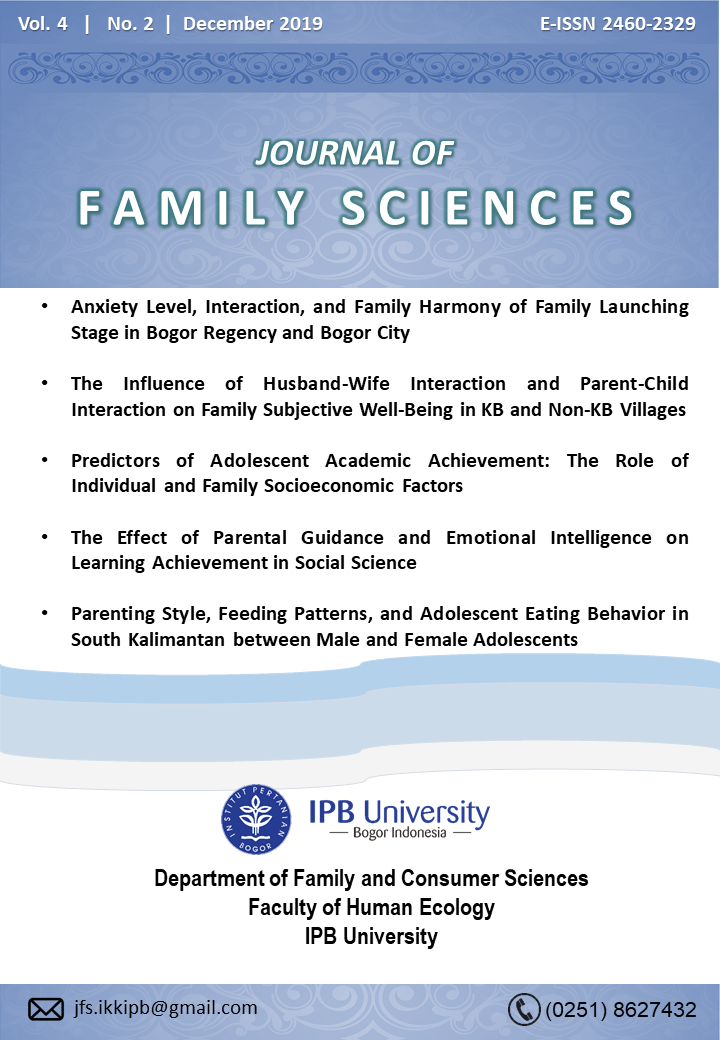Parenting Style, Feeding Patterns, and Adolescent Eating Behavior in South Kalimantan between Male and Female Adolescents
Abstract
Parenting style and parenting eating patterns are a way of controlling teenagers eating behavior. This study aims 1) to analyze gender differences in adolescent characteristics, family characteristics, feeding patterns, and eating behavior; 2) to analyze the effect of adolescent characteristics, family characteristics, and feeding patterns on adolescent eating behavior. This study used a cross-sectional study design with survey methods. The sample of this study was 160 adolescents (61 boys and 99 girls who were in grade 10 of high school). The results of the T-test showed that there were no significant gender differences in adolescent characteristics and family characteristics. There were significant differences in authoritarian parenting style, feeding patterns and eating behavior between boys and girls. The results of the regression analysis showed that eating behavior was influenced by age and feeding patterns.
Downloads
References
Ambrosini, G. L., Oddy, W. H., Robinson, M., O'Sullivan, T. A., Hands, B. P., de Klerk, N. H., & Beilin, L. J. (2009). Adolescent dietary patterns are associated with lifestyle and family psycho-social factors. Public Health Nutrition, 12(10), 1807-15. http://dx.doi.org/10.1017/1368980008004618.
Barasi, M. (2009). At a Glance: Ilmu Gizi (Hermin, Transl.). Jakarta: Penerbit Erlangga.
Baumrind, D. (1987). A developmental perspective on adolescent risk-taking behavior in contemporary America. In W. Damon (Ed.), New Directions for Child Development: Adolescent Health and Social Behavior (Vol. 37, pp. 93-126). San Francisco: Jossey-Bass.
Bee, H. L., & Boyd, D. (2004). The Developing Child (10th ed.). London: Pearson Education.
Berge, J. M., Wall, M., Larson, N., Eisenberg, M. E., Loth, K. A., & Neumark-sztainer, D. (2014). The unique and additive associations of family functioning and parenting practices with disordered eating behaviors in diverse adolescents. Journal of Behavioral Medicine, 37(2), 205-17. http://dx.doi.org/10.1007/10865.012.9478.1.
Birch, L. L., & Fisher J. O. (1998). Development of eating behaviors among children and adolescents. Pediatrics, 101, 539-549.
Birch, L. L., Fisher, J. O., & Davison, K. K. (2003). Learning to overeat: maternal use of restrictive feeding practices promotes girls’ eating in the absence of hunger. American Journal of Clinical Nutrition, 78(2), 215-220. http://dx.doi.org/10.1093/ajcn/78.2.215
Bobak. (2005). Perilaku Makan Sehat. Jakarta: Salemba Medika.
Bronfenbrenner, U. (1994). Ecological models of human development. In International Encyclopedia of Education (Vol. 3, 2nd ed., pp. 37-43). Oxford: Elsevier.
Buri, J. R. (1991). Parental authory questionaire. Journal of Personality and Social Assesment, 57(1), 110-119.
Giskes, K., Patterson, C., Turrell, G., & Newman, B. (2005). Health and nutrition beliefs and perceptions of Brisbane adolescents. Nutrition & Dietetics, 62(2-3), 69–75. http://dx.doi.org/10.1111/j.1747-0080.2005.00002.x
Hastuti, D. (2015). Pengasuhan: Teori dan Prinsip serta Aplikasi di Indonesia. Bogor: IPB Press.
Hughes, S. O., Hayes, J. T., Sigman-Grant, M., & VanBrackle, A. (2017). Potential use of food/activity, parenting style, and caregiver feeding style measurement tools with American Indian families: a brief report. Maternal and Child Health Journal, 21(2), 242-247. http://dx.doi.org/10.1007/s10995-016-2145-3
Karyadi, L. (1985). Pengaruh pola asuh makan terhadap kesulitan makan anak bawah tiga tahun (batita) (Unpublished master’s thesis). IPB University, Bogor.
Kementerian Kesehatan. (2015). Rencana Strategis Kementerian Kesehatan Tahun 2015-2019. Jakarta: Kementerian Kesehatan RI.
Khomsan, A. (2003). Pangan dan Gizi Untuk Kesehatan. Jakarta: PT Rajagrafindo Persada.
Kitzman-Ulrich, H., Wilson, D. K., St George, S. M., Segal, M., Schneider, E., & Kugler, K. (2011). A preliminary test of a motivational and parenting weight loss program targeting low-income and minority adolescents. Childhood Obesity, 7(5), 379-384. http://dx.doi.org/10.1089/2011.0030.
Kurniawan, M. Y., Briawan, D., & Caraka, R. E. (2015). Persepsi tubuh dan gangguan makan pada remaja. Jurnal Gizi Klinik Indonesia, 11(3), 105-114. http://dx.doi.org/10.22146/ijcn.19287
Larson, N., MacLehose, R., Fulkerson, J. A., Berge, J. M., Story, M., & Neumark-Sztainer, D. (2013). Eating breakfast and dinner together as a family: associations with sociodemographic characteristics and implications for diet quality and weight status. Journal of the Academy of Nutrition and Dietetics, 113(12), 1601-1609. http://dx.doi.org/10.1016/j.jand.2013.08.011.
Li, J., Loerbroks, A., & Siegrist, J. (2017). Effort–reward Imbalance at work, parental support, and suicidal ideation in adolescents: a cross-sectional study from Chinese dual-earner families. Safety and Health at Work, 8(1), 77-83. http://dx.doi.org/10.1016/j.shaw.2016.09.003
Lohman, B. J., Gillette, M. T., & Neppl, T. K. (2016). Harsh parenting and food insecurity in adolescence: the association with emerging adult obesity. Journal of Adolescent Health, 59(1), 123-127. http://dx.doi.org/10.1016/j.jadohealth.2016.03.024
Loth, K. A., MacLehose, R. F., Fulkerson, J. A., Crow, S., & Neumark-Sztainer, D. (2013). Food-related parenting practices and adolescent weight status: a population-based study. Pediatrics, 131(5), 1443-1450.
Loth, K. A., MacLehose, R. F., Fulkerson, J. A., Crow, S., & Neumark‐Sztainer, D. (2014). Are food restriction and pressure‐to‐eat parenting practices associated with adolescent disordered eating behaviors?. International Journal of Eating Disorders, 47(3), 310-314.
Loth, K., Wall, M., Choi, C.W., Bucchianeri, M., Quick, V., Larson, N., & Neumark‐Sztainer, D. (2015). Family meals and disordered eating in 41 adolescents: Are the benefits the same for everyone?. International Journal of Eating Disorders, 48(1), 100-110. http://dx.doi.org/10.1002/eat.22189
Monteagudo, C., Palacín-Arce, A., Bibiloni, M. D. M., Pons, A., Tur, J. A., Olea-Serrano, F., & Mariscal-Arcas, M. (2013). Proposal for a breakfast quality index (BQI) for children and adolescents. Public Health Nutrition, 16(4), 639-44. http://dx.doi.org/10.1017/1368980012003175.
Pearson, N., Atkin, A. J., Biddle, S. J. H., Gorely, T., & Edwardson, C. (2010). Parenting styles, family structure and adolescent dietary behaviour. Public Health Nutrition, 13(8), 1245-1253. http://dx.doi.org/10.1017 /1368980009992217.
Pinquart, M. (2014). Associations of general parenting and parent–child relationship with pediatric obesity: a meta-analysis. Journal of Pediatric Psychology, 39(4), 381-393. http://dx.doi.org/10.1093/jpepsy/jst144
Respati, W. S., Yulianto, A., & Widiana, N. (2006). Perbedaan konsep diri antara remaja akhir yang mempersepsi pola asuh orang tua authoritarian, permissive, dan authoritative. Jurnal Psikologi, 4(2), 119-138.
Riset Kesehatan Dasar. (2013). Badan Penelitian dan Pengembangan Kesehatan Kementerian RI tahun 2013. Global School Health Survey. Retrieved from https://www.depkes.go.id/resources/download/general/Hasil%20Riskesdas%202013.pdf
Rozenblat, V., Ryan, J., Wertheim, E., King, R., Olsson, C. A., Letcher, P., & Krug, I. (2017). Relationships between self‐reported and observed parenting behaviour, adolescent disordered eating attitudes and behaviours, and the 5‐HTTLPR Polymorphism: Data From the Australian Temperament Project. European Eating Disorders Review, 25(5), 381-388. http://dx.doi.org/10.1002/erv.2530
Sarintohe & Prawitasari. (2006). Perilaku Makan Tidak Sehat. Jakarta: Rineka Cipta.
Story, M., Neumark-Sztainer, D., & French, S. (2002). Individual and environmental influences on adolescent eating behaviors. Journal of the American Dietetic Association, 102(3), S40–S51. http://dx.doi.org/10.1016/s0002-8223(02)90421-9
Tantiani, T., & Syafiq, A. (2008). Perilaku makan menyimpang pada remaja di Jakarta. Kesmas: National Public Health Journal, 2(6), 255-262. http://dx.doi.org/10.21109/kesmas.v2i6.245
Wang, H., Kim, J., Su, D., Xu, L., Chen, L. W., & Huang, T. T-K. (2014). Joint influence of individual choices, parenting practices, and physician advice on adolescent obesity, Nebraska, 2008. Preventing Chronic Disease, 11(E175), 140210. http://dx.doi.org/ 10.5888/pcd11.140210
Willett, W. C., Sampson, L., Stampfer, M. J., Rosner, B., Bain, C., Witschi, J., Hennekens, C. H., & Speizer, F. E. (1985). Reproducibility and validity of a semiquantitative food frequency questionnaire. American Journal of Epidemiology, 122(1), 51-65. http://dx.doi.org/10.1093/oxfordjournals.aje.a114086
Zahra, J., Ford, T., & Jodrell, D. (2014). Cross‐sectional survey of daily junk food consumption, irregular eating, mental and physical health and parenting style of British secondary school children. Child: Care, Health and Development, 40(4), 481-491. http://dx.doi.org/10.1111/cch.12068
Authors who publish with this journal agree to the following terms:
- Authors retain copyright and grant the journal right of first publication with the work simultaneously licensed under a Creative Commons Attribution 4.0 International License that allows others to share the work with an acknowledgement of the work's authorship and initial publication in this journal.
- Authors are able to enter into separate, additional contractual arrangements for the non-exclusive distribution of the journal's published version of the work (e.g., post it to an institutional repository or publish it in a book), with an acknowledgement of its initial publication in this journal.
- Authors are permitted and encouraged to post their work online (e.g., in institutional repositories or on their website) prior to and during the submission process, as it can lead to productive exchanges, as well as earlier and greater citation of published work (See The Effect of Open Access).



_001.png)



